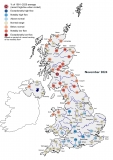Most of the catchment descriptors and statistics given here are based, directly or indirectly, on the Integrated Hydrological Digital Terrain Model (IHDTM) and may differ slightly from corresponding descriptors derived using different digital terrain models. For a few gauging stations where the drainage paths are difficult to determine (e.g. for some spring sources) or do not reflect local topography (e.g. artificial channels used for water transfers), realistic catchment descriptors cannot be derived. Full list of FEH Catchment Descriptors is provided in the table below, followed by more detailed description of some of the most widely used descriptors. Details of the derivation and utility of these descriptors are given in Volume 5 of the Flood Estimation Handbook (FEH) REF1.
ALTBAR
Mean catchment altitude (m above sea level), derived from the IHDTM.
ASPBAR
Index representing the dominant aspect of catchment slopes (°).
ASPVAR
Index representing the invariability in aspect of catchment slopes (°).
AREA
Catchment drainage area (km2), derived from the IHDTM.
BFIHOST
This base flow index is a measure of catchment responsiveness derived using the 29-class Hydrology Of Soil Types (HOST) classificationREF2. The HOST dataset is available as a 1km grid which records, for each grid square, the percentage associated with each HOST class present. Using IHDTM boundaries for each gauged catchment, the soil characteristics of the catchment can be indexed and by exploiting the relationship between soil typologies and runoff response an aggregated assessment of BFIHOST for the catchment can be derived.
Note: there is a strong general association between BFIHOST and the Baseflow Index derived using the hydrograph separation approach, but no close equivalence can be expected where the natural flow regime is substantially disturbed e.g. by compensation flows or major augmentation from sewage effluent.
BFIHOST19
The estimate of the base flow index (BFI) based on the Hydrology of Soil Types (HOST) classification, BFIHOST, provides a measure of catchment responsiveness. The new BFIHOST19 descriptor addresses a number of issues in the original BFIHOST developed in 1995, including:
- the BFI calculated through base flow separation tended to be underestimated in clay-dominated catchments,
- the calculation technique performed poorly in ephemeral catchments or those with missing data, and
- the pragmatic bounding of BFI coefficients for permeable soils overlying aquifer outcrops was also problematic for small catchments.
CENTROID
Centroid of the catchment, in kilometres. This descriptor was first used in HiFlows-UK Version 3.
DDF
An estimate of the depth of precipitation for a specified duration and frequency or recurrence interval.
DPLBAR
Mean of distances between each node on the IHDTM grid and the catchment outlet, in kilometres. Used to characterise catchment size and configuration.
DPSBAR
This landform descriptor (mean Drainage Path Slope) provides an index of overall catchment steepness. It was developed for the Flood Estimation Handbook and is calculated as the mean of all inter-nodal slopes (derived using the IHDTM) for the catchment. The index is expressed in metres per kilometre with values ranging from >300 in mountainous terrain to <25 in the flattest parts of the country.
FARL
Any reservoirs or lakes within a catchment will tend to have some effect on flood response, but it is those directly linked to the stream network that are most likely to produce an attenuation effect. The Flood Attenuation by Reservoirs and Lakes (FARL) index, developed for the Flood Estimation Handbook, provides a guide to the degree of flood attenuation attributable to reservoirs and lakes in the catchment above a gauging station. Values close to unity indicate the absence of attenuation due to lakes and reservoirs whereas index values below 0.8 indicate a substantial influence on flood response.
FPDBAR
The mean depth of water on floodplains in a 100-year event. This descriptor was first used in HiFlows-UK Version 3.
FPEXT
The floodplain extent is defined as the fraction of the catchment that is estimated to be inundated by a 100-year flood. This descriptor was first used in HiFlows-UK Version 3.
FPLOC
The location of floodplains within the catchment is described using the same principles employed to derive values of the FEH index URBLOC. This descriptor was first used in HiFlows-UK Version 3.
LDP
Longest drainage path (in kilometres), defined by recording the greatest distance from a catchment node to the defined outlet.
PROPWET
Dry soils tend to inhibit flood formation whilst, in contrast, saturated soil conditions precede and contribute to many large flood events. This catchment wetness index (PROPortion of time soils are WET), developed for the Flood Estimation Handbook, provides a measure of the proportion of time that catchment soils are defined as wet (in this context, when soil moisture deficits are less than 6mm). PROPWET values range from over 80% in the wettest catchments to less than 20% in the driest parts of the country.
SAAR
Average annual rainfall in the standard period (1961-1990) in millimetres. (SAAR4170 is from 1941 to 1970). Further information can be found here.
SPRHOST
Standard percentage runoff (%) associated with each HOST soil class. This can be used to derive SPRHOST over a catchment. SPRHOST can be derived from flow data where available.
URBEXT1990 / 2000
Index of urban and suburban land cover in 1990 / 2000 expressed as a fraction.
URBCON1990 / 2000
Index of the concentration of urban and suburban land cover in 1990 / 2000 expressed as a fraction.
URBLOC1990 / 2000
Index of the location of urban and suburban land cover in 1990 / 2000 expressed as a fraction.
REF1 Institute of Hydrology. 1999. Flood Estimation Handbook, 5 volumes and associated software. Institute of Hydrology. See here.
REF2 Boorman, D. B. Hollis, J. M. and Lilly, A. 1995. Hydrology of Soil Types: a hydrologically-based classification of the soils of the United Kingdom. IH Report No. 126. Institute of Hydrology, Wallingford.



